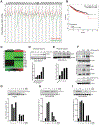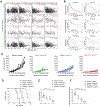Cyclophilin A Inhibitor Debio-025 Targets Crk, Reduces Metastasis, and Induces Tumor Immunogenicity in Breast Cancer
- PMID: 32321766
- PMCID: PMC8045419
- DOI: 10.1158/1541-7786.MCR-19-1144
Cyclophilin A Inhibitor Debio-025 Targets Crk, Reduces Metastasis, and Induces Tumor Immunogenicity in Breast Cancer
Abstract
The Crk adaptor protein, a critical modifier of multiple signaling pathways, is overexpressed in many cancers where it contributes to tumor progression and metastasis. Recently, we have shown that Crk interacts with the peptidyl prolyl cis-trans isomerase, Cyclophilin A (CypA; PP1A) via a G219P220Y221 (GPY) motif in the carboxyl-terminal linker region of Crk, thereby delaying pY221 phosphorylation and preventing downregulation of Crk signaling. Here, we investigate the physiologic significance of the CypA/Crk interaction and query whether CypA inhibition affects Crk signaling in vitro and in vivo. We show that CypA, when induced under conditions of hypoxia, regulates Crk pY221 phosphorylation and signaling in cancer cell lines. Using nuclear magnetic resonance spectroscopy, we show that CypA binds to the Crk GPY motif via the catalytic PPII domain of CypA, and small-molecule nonimmunosuppressive inhibitors of CypA (Debio-025) disrupt the CypA-CrkII interaction and restores phosphorylation of Crk Y221. In cultured cell lines, Debio-025 suppresses cell migration, and when administered in vivo in an orthotopic model of triple-negative breast cancer, Debio-025 showed antitumor efficacy either alone or in combination with anti-PD-1 mAb, reducing both tumor volume and metastatic lung dispersion. Furthermore, when analyzed by NanoString immune profiling, treatment of Debio-025 with anti-PD-1 mAb increased both T-cell signaling and innate immune signaling in tumor microenvironment. IMPLICATIONS: These data suggest that pharmacologic inhibition of CypA may provide a promising and unanticipated consequence in cancer biology, in part by targeting the CypA/CrkII axis that regulates cell migration, tumor metastasis, and host antitumor immune evasion.
©2020 American Association for Cancer Research.
Conflict of interest statement
Disclosure of Potential Conflicts of Interest
No potential conflicts of interest were disclosed.
Figures






Similar articles
-
Cyclophilin A promotes cell migration via the Abl-Crk signaling pathway.Nat Chem Biol. 2016 Feb;12(2):117-23. doi: 10.1038/nchembio.1981. Epub 2015 Dec 14. Nat Chem Biol. 2016. PMID: 26656091 Free PMC article.
-
Crk adaptor proteins act as key signaling integrators for breast tumorigenesis.Breast Cancer Res. 2012 May 8;14(3):R74. doi: 10.1186/bcr3183. Breast Cancer Res. 2012. PMID: 22569336 Free PMC article.
-
Immunophilins control T lymphocyte adhesion and migration by regulating CrkII binding to C3G.J Immunol. 2014 Oct 15;193(8):3966-77. doi: 10.4049/jimmunol.1303485. Epub 2014 Sep 15. J Immunol. 2014. PMID: 25225668
-
A new twist to adaptor proteins contributes to regulation of lymphocyte cell signaling.Trends Immunol. 2008 Aug;29(8):388-96. doi: 10.1016/j.it.2008.04.006. Epub 2008 Jul 1. Trends Immunol. 2008. PMID: 18599349 Review.
-
CypA: A Potential Target of Tumor Radiotherapy and/or Chemotherapy.Curr Med Chem. 2021;28(19):3787-3802. doi: 10.2174/0929867327666201029161055. Curr Med Chem. 2021. PMID: 33121398 Review.
Cited by
-
A Critical Role of Peptidylprolyl Isomerase A Pseudogene 22/microRNA-197-3p/Peptidylprolyl Isomerase A Axis in Hepatocellular Carcinoma.Front Genet. 2021 Mar 15;12:604461. doi: 10.3389/fgene.2021.604461. eCollection 2021. Front Genet. 2021. PMID: 33790943 Free PMC article.
-
Repurposing of cyclophilin A inhibitors as broad-spectrum antiviral agents.Drug Discov Today. 2022 Jul;27(7):1895-1912. doi: 10.1016/j.drudis.2022.05.016. Epub 2022 May 21. Drug Discov Today. 2022. PMID: 35609743 Free PMC article. Review.
-
Inhibitors of Cyclophilin A: Current and Anticipated Pharmaceutical Agents for Inflammatory Diseases and Cancers.Molecules. 2024 Mar 11;29(6):1235. doi: 10.3390/molecules29061235. Molecules. 2024. PMID: 38542872 Free PMC article. Review.
-
Cyclophilin a represses reactive oxygen species generation and death of hypoxic non-small-cell lung cancer cells by degrading thioredoxin-interacting protein.Cell Cycle. 2022 Sep;21(18):1996-2007. doi: 10.1080/15384101.2022.2078615. Epub 2022 May 30. Cell Cycle. 2022. PMID: 35579671 Free PMC article.
-
Bioinformatics analysis and experimental validation of tumorigenic role of PPIA in gastric cancer.Sci Rep. 2023 Nov 5;13(1):19116. doi: 10.1038/s41598-023-46508-y. Sci Rep. 2023. PMID: 37926757 Free PMC article.
References
-
- Matsuda M, Mayer BJ, Fukui Y, Hanafusa H. Binding of transforming protein, P47gag-crk, to a broad range of phosphotyrosine-containing proteins. Science 1990;248:1537–9. - PubMed
-
- Mayer BJ, Hamaguchi M, Hanafusa H. A novel viral oncogene with structural similarity to phospholipase C. Nature 1988;332:272–5. - PubMed
-
- Hanafusa H Protein phosphorylation and cell transformation. Zhonghua Min Guo Wei Sheng Wu Ji Mian Yi Xue Za Zhi 1991;24:1–9. - PubMed
Publication types
MeSH terms
Substances
Grants and funding
LinkOut - more resources
Full Text Sources
Medical

